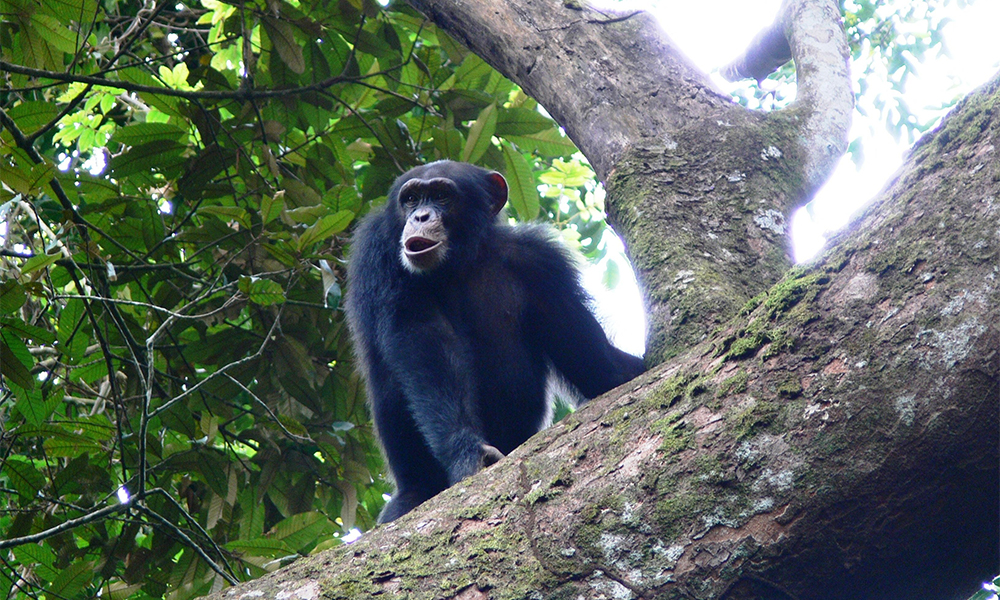Chimpanzees in one part of Guinea crack and eat nuts while others declined to do so even when offered tools, research published on Monday found, and the difference could shed light on their culture. As humans, we are said to have cumulative culture: skills and technologies are transmitted and refined from generation to generation, producing behaviors more sophisticated than a single person could dream up.
Some experts believe this is unique to humans, and that traits like tool use by chimps instead develops spontaneously in individuals. Their theory argues animals can innovate certain behaviors without a model to copy. Evidence for this comes in part from captive chimps, who have been seen apparently independently developing simple tool use like scooping with a stick and sponging with a leaf.
But those behaviors differ from comparatively more complex techniques, like cracking nuts, and captivity is vastly different to the wild. So Kathelijne Koops, a professor in the University of Zurich’s anthropology department, designed a series of experiments involving wild chimpanzees in Guinea. While one population of chimps in Guinea’s Bossou does crack nuts, another group just six kilometers away in Nimba does not. Koops wanted to see whether the Nimba population would develop the behavior if introduced to the tools to do so.
The researchers set up four different scenarios: in the first, the chimps encountered palm nuts in shells, and stones that could be used for cracking them open. In the second, there were palm nuts in shells, stones, but also edible palm nut fruit. In the third, they found the stones, unshelled palm nuts and some cracked nut shells. And the final experiment offered them stones and Coula nuts, which are more commonly and easily cracked by chimpanzee populations that use the technique.
 Photo shows the Nimba Range in the Guinean montane forests. Chimpanzees crack and eat nuts, but others declined to do so even when offered the tools, and the difference could shed light on chimp culture. — AFP
Photo shows the Nimba Range in the Guinean montane forests. Chimpanzees crack and eat nuts, but others declined to do so even when offered the tools, and the difference could shed light on chimp culture. — AFPSecret cameras
Each experiment ran for several months at a time, mostly in 2008, though in some cases as late as 2011. But while the experiment sites in Nimba were visited and explored by dozens of chimpanzees, who were filmed with cameras installed at the location, not once did they attempt to crack a nut. “Having observed nut cracking by Bossou chimpanzees on many occasions, it was so interesting to watch the Nimba chimpanzees interact with the same materials without ever cracking a nut,” Koops told AFP.
The study, published Monday in the journal Nature Human Behavior suggests that nut cracking may in fact be an outcome of cumulative culture, similar to that of humans. The researchers acknowledged difficulties studying chimps in the wild, including the inability to control the numbers visiting their sites. Between 16 and 53 chimps visited each site during the experiments and primate behavior specialist Professor Gisela Kaplan, who was not involved with the research, questioned whether the numbers were sufficient to draw broad conclusions.
“As in human society: the number of innovators is relatively small in animals and the expression of innovation depends also on many social and ecological circumstances and pressures,” said Kaplan, professor emerita in animal behaviour at the University of New England, Australia. The study’s authors acknowledge there are other possible explanations for the chimps’ reticence, including the possibility that they simply weren’t motivated to eat the nuts.
But as chimpanzees in neighboring areas do crack nuts, they consider it unlikely the Nimba population was uninterested in a new food source. Koops said the involvement of a “normal-sized wild community” of chimps and the length of the experiments allow insights. “Of course it would be interesting to test additional communities,” she said. But the findings so far suggest there may be “greater continuity between chimpanzee and human cultural evolution than is normally assumed.”— AFP











